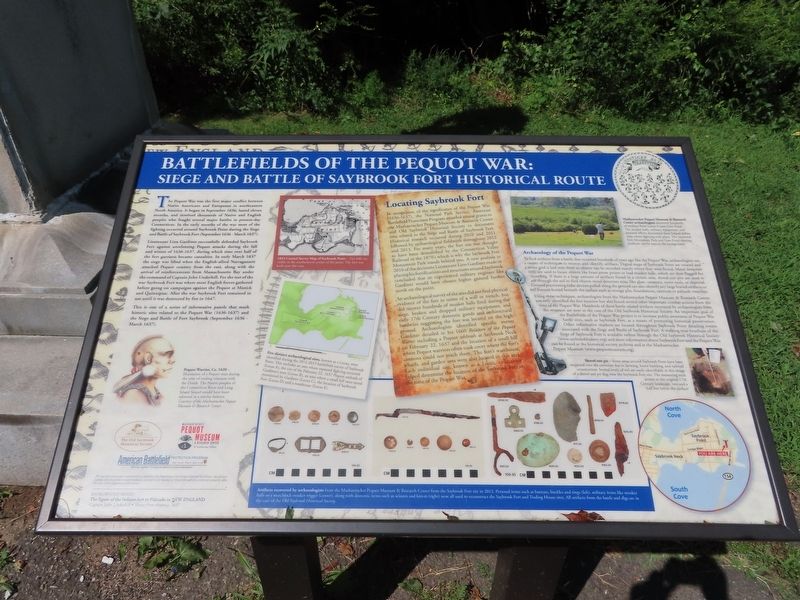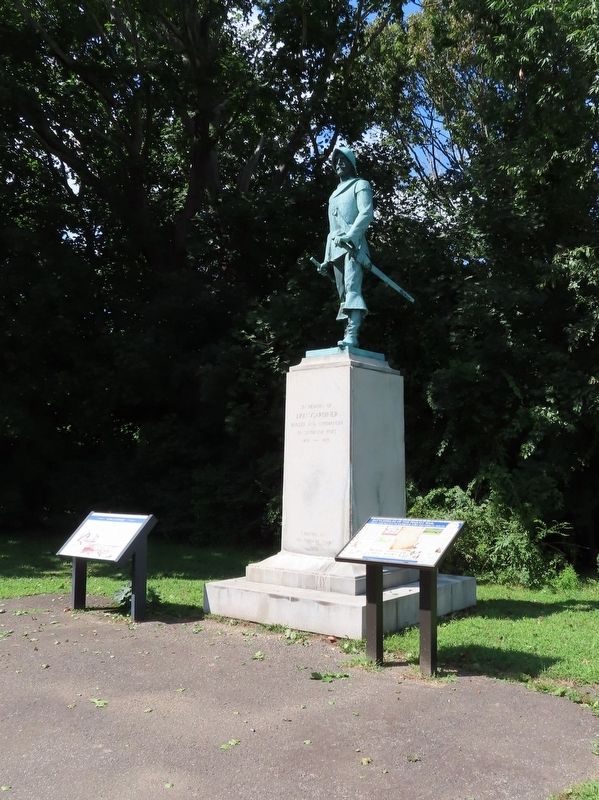Old Saybrook Center in Middlesex County, Connecticut — The American Northeast (New England)
Battlefields of the Pequot War
Siege and Battle of Saybrook Fort Historical Route
The Pequot War was the first major conflict between Native Americans and Europeans in northeastern North America. It began in September 1636, lasted eleven months, and involved thousands of Native and English peoples who fought several major battles in present-day Connecticut. In the early months of the war most of the fighting occurred about a half-mile east of this marker during the Siege and Battle of Saybrook Fort (September 1636 - March 1637).
Lieutenant Lion Gardiner successfully defended Saybrook Fort against unrelenting Pequot attacks during the fall and winter of 1636-1637, during which time over half of the fort garrison became casualties. In early March 1637 the siege was lifted when the English-allied Narragansett attacked Pequot country from the east, along with the arrival of reinforcements from Massachusetts Bay under the command of Captain John Underhill. For the rest of the war Saybrook Fort was where most English forces gathered before going on campaigns against the Pequot at Mistick and Quinnipiac. After the war Saybrook Fort remained in use until it was destroyed by fire in 1647.
This is one of a series of informative panels that mark historic sites related to the Pequot War (1636-1637) and the Siege and Battle of Fort Saybrook (September 1636 - March 1637).
Locating Saybrook Fort
In recognition of the significance of the Pequot War (1636-1637), the National Park Service, American Battlefield Protection Program awarded several grants to the Mashantucket Pequot Museum & Research Center and Old Saybrook Historical Society to document sites related to the Siege and Battle of Saybrook Fort. Historical research occurred during 2010 and 2011 followed by archaeological fieldwork throughout 2012 and 2013. For many years, the fort site was thought to have been demolished by the Connecticut Valley Railroad in the 1870's which is why the Saybrook Fort Monument Park stands behind you. A new analysis in 2010 of the decisions Lieutenant Lion Gardiner made in placing his fortifications and structures around Saybrook concluded that an experienced military engineer like Gardiner would have chosen higher ground further north on the point.
An archaeological survey of the area did not find physical evidence of the fort in terms of a wall or trench, but did recover hundreds of musket balls fired during the siege, broken and dropped military equipment, and early 17th Century domestic goods and architectural hardware suggesting the fort was located on the high ground. Archaeologists identified specific events Gardiner detailed in his 1660 Relation of the Pequot Warres including a Pequot ambush at Saybrook Neck on February 22, 1637 and the location of a small hill
where Pequot warriors often took cover where the fort's cannons could not reach them. The fort's warehouse, wharfs, and garden area were also located in this area. Each individual site, known as a Locus, collectively helped determine the location of the Saybrook Fort at the time of the Pequot War.
Archaeology of the Pequot War To find artifacts from a battle that occurred hundreds of years ago like the Pequot War, archaeologists use a variety of techniques to recover, and identify, artifacts. Digital maps of Saybrook Point are created and a meter grid is laid over them so objects can be recorded exactly where they were found. Metal detectors (left) are used to locate objects like brass arrow points or lead musket balls, which are then flagged for recording. If there is a large amount of artifacts found in a certain area, shovel test pits are used to sift through the soil to find objects metal detectors miss, like glass, ceramics, stone tools, or charcoal. Ground penetrating radar devices pulled along the ground can also identify any large buried artifacts or soil features buried beneath the surface such as storage pits, foundations, cannons or palisade trenches.
Using these techniques, archaeologists from the Mashantucket Pequot Museum & Research Center not only identified the fort location but also found several other important combat actions from the time of the Pequot War. Hundreds of these battle related artifacts recovered by archaeologists from the museum are now in the care of the Old Saybrook Historical Society. An important goal of the Battlefields of the Pequot War project is to increase public awareness of Pequot War battle sites, such as Saybrook Fort, as a means of promoting historical preservation. Other informative markers are located throughout Saybrook Point detailing events associated with the Siege and Battle of Saybrook Fort. A walking tour brochure of the Siege of Saybrook Fort is available online through the Old Saybrook Historical Society (www.saybrookhistory.org) and more information about Saybrook Fort and the Pequot War can be found at the historical society archives and at the Mashantucket Pequot Museum (www.pequotmuseum.org).
( photo captions )
Pequot Warrior, Ca. 1620 — Illustration of a Pequot man during the time of trading relations with the Dutch. The Native peoples of the Connecticut River and Long Island Sound would have been adorned in a similar fashion. Courtesy of the Mashantucket Pequot Museum & Research Center
1853 Coastal Survey Map of Saybrook Point - Two hills are visible in the northeastern comer of the point. The fort was built near this area.
Five distinct archaeological sites, known as a Locus, were identified during the 2012-2013 battlefield survey of Saybrook Point. This includes an area where repeated fighting occurred (Locus A), the site of the February 22, 1637 Pequot ambush of Gardiner's men (Locus B), an area where a small hill once stood mentioned by Gardiner (Locus C), the location of Saybrook Fort (Locus D) and a warehouse (Locus E).
Mashantucket Pequot Museum & Research Center archaeologists recovered hundreds of artifacts from Locus A near Gees Pond. The musket balls, military equipment, and personal effects discovered there helped define areas where fighting took place. The Saybrook Fort Monument Park and Gees Pond viewing platform can be seen in the background.
Shovel test pit - Some areas around Saybrook Point have been impacted over the centuries due to farming, home building, and railroad construction. Several levels of soil are easily identifiable in this image of a shovel test pit dug near the Saybrook Fort site. The measuring stick points to the original 17th Century landscape, two and a half feet below the surface!
Artifacts recovered by archaeologists from the Mashantucket Pequot Museum & Research Center from the Saybrook Fort site in 2013. Personal items such as buttons, buckles and rings (left), military items like musket balls or a matchlock musket trigger (center), along with domestic items such as scissors and knives (right) were all used to reconstruct the Saybrook Fort and Trading House sites. All artifacts from the battle and digs are in the care of the Old Saybrook Historical Society.
Background Image: The figure of the Indians fort or Palizado in New England Captain John Underhill • Newes from America, 1637
Topics. This historical marker is listed in these topic lists: Colonial Era • Forts and Castles • Native Americans. A significant historical date for this entry is February 22, 1637.
Location. 41° 17.059′ N, 72° 21.167′ W. Marker is in Old Saybrook, Connecticut, in Middlesex County. It is in Old Saybrook Center. Marker is on College Street (Connecticut Route 154) east of Fenwick Street when traveling east. Located in Fort Saybrook Monument Park. Touch for map. Marker is in this post office area: Old Saybrook CT 06475, United States of America. Touch for directions.
Other nearby markers. At least 8 other markers are within walking distance of this marker. Lion Gardiner (here, next to this marker); Say Brooke Fort (a few steps from this marker); Fort Saybrook – 1635 (within shouting distance of this marker); The Fenwicks (within shouting distance of this marker); The Pequot War (within shouting distance of this marker); Winthrop and the Warwick Patent (within shouting distance of this marker); The Connecticut River (within shouting distance of this marker); The Saybrook Bar (about 300 feet away, measured in a direct line). Touch for a list and map of all markers in Old Saybrook.
Also see . . .
1. Pequot War (Wikipedia). (Submitted on October 4, 2021, by Michael Herrick of Southbury, Connecticut.)
2. Old Saybrook Historical Society. (Submitted on October 4, 2021, by Michael Herrick of Southbury, Connecticut.)
Credits. This page was last revised on February 10, 2023. It was originally submitted on October 4, 2021, by Michael Herrick of Southbury, Connecticut. This page has been viewed 141 times since then and 21 times this year. Photos: 1, 2. submitted on October 4, 2021, by Michael Herrick of Southbury, Connecticut.

